Exploring Rock Saws: Types, Techniques, and Uses
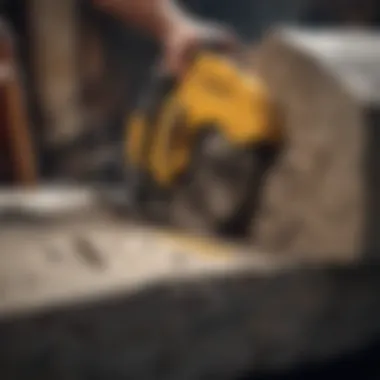
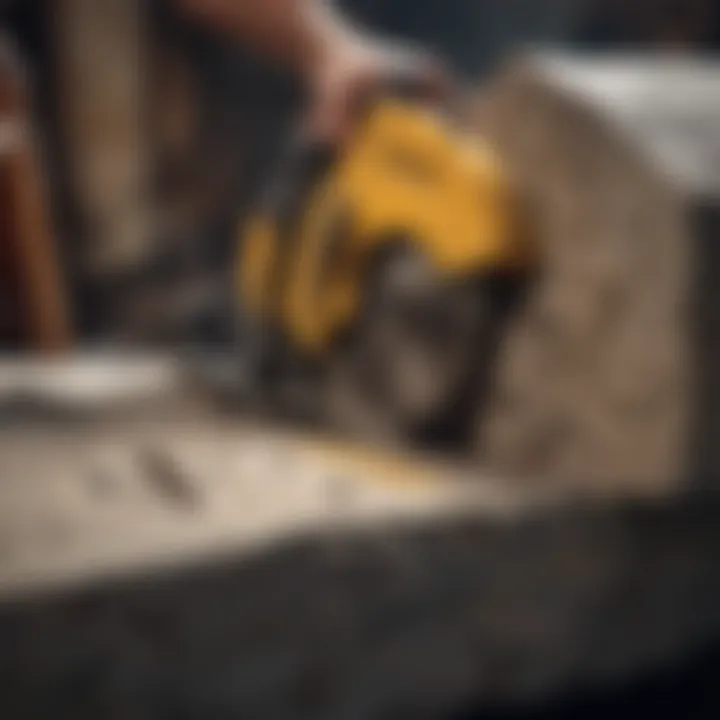
Intro
Rock saws represent a specialized segment of tools pivotal for anyone serious about rock and fossil collection. With the increasing interest in geological studies and the DIY fossil hunting movement, understanding these tools' intricacies is paramount. This article will guide you through the various types of rock saws, the techniques employed in utilizing them, and the applications across several fields, including geology, mining, and fossil preparation.
We will also shed light on the historical context of these tools, identify and classify various rocks and fossils, and look at future trends that promise to reshape rock saw technology. Safety considerations and proper maintenance will be addressed to ensure both effectiveness and longevity of these essential tools.
History and Origins
Overview of Collectibles, Rocks, and Fossils
From a very early age, humans have exhibited a fascination with the natural world, manifesting in the collection of unique rocks and fossils. These collectibles often tell stories of the Earth’s history, showcasing shifts in time through their physical forms. Before the advent of modern tools, enthusiasts utilized crude methods to observe and select these treasures, often relying on hand tools and sheer determination.
The desire to polish, cut, and manipulate these treasures led to the development of various types of blades and techniques. Initially, primitive saws made from iron and other metals emerged, giving way to more sophisticated designs as the technology progressed. Today’s rock saws leverage engineered materials and advanced cutting methods, enabling collectors to achieve greater precision in their work.
Historical Significance and Cultural Impact
The historical significance of rock and fossil collections cannot be overstated. In many cultures, these natural artifacts served as not just collectibles but also as markers of geological and historical identity. For instance, Native American tribes often utilized specific stones, such as flint, to craft tools, which were intrinsic to their survival. Likewise, fossils often appear in scholarly works, contributing to our understanding of ancient life.
In modern times, the enthusiasm for collecting both rocks and fossils has burgeoned into a robust community. Museums host exhibits that display these collections, engaging the public while researchers continue to investigate the stories each specimen holds. Furthermore, we have seen a rise in educational programs designed to inspire a new generation of collectors.
Identification and Classification
Guide to Identifying Rocks and Fossils
Identifying rocks and fossils can feel daunting, but with some guided principles, collectors can navigate this intriguing landscape. Here are some essential traits to consider:
- Color and Texture: Each rock type harbors unique colors and textures. Sedimentary rocks often display layered patterns, while igneous rocks may sparkle due to the presence of quartz or mica.
- Luster: Reflectiveness varies widely; for instance, metallic luster signifies the presence of particular minerals, while a dull appearance may indicate weathered surface conditions.
- Hardness: The Mohs scale provides a benchmark for testing hardness, helping enthusiasts distinguish between softer and harder specimens effectively.
Common Types and Variations
Rocks and fossils can be classified into several categories, each with distinctive features:
- Igneous Rocks: Formed from cooled magma or lava. Common examples include granite and basalt.
- Sedimentary Rocks: These originate from sediment accumulation and can house fossils, like sandstone or limestone.
- Metamorphic Rocks: Resulting from heat and pressure, types such as marble and schist are part of this group.
- Fossils: Remains of ancient organisms, fossil types include cast, mold, and trace fossils. Each offers insights into past life forms and their environments.
"Understanding the classification of rocks and fossils not only aids in their identification but enriches the entire collecting experience, turning it into a vibrant story woven through time."
This overview lays the groundwork for the later sections of this article, where we will delve into the techniques and tools that bring these fascinating materials to light. A well-rounded grasp of the history and classification will better prepare collectors to use rock saws effectively and safely, paving the way for successful explorations in the field.
Preamble to Rock Saws
The use of rock saws is pivotal in fields like geology, mining, and fossil preparation. These specialized tools allow for precise cutting and shaping of various types of rock, providing opportunities for detailed study and preservation. Rock saws have become indispensable in these disciplines, not just for professionals but also for enthusiasts and collectors who seek to unearth the beauty and history hidden within the earth. Understanding the ins and outs of rock saws, including their types and operational methodologies, can significantly enhance one’s ability to handle materials effectively and safely.
Definition and Purpose
Rock saws are essentially power tools designed to slice through stone, concrete, and various types of hard materials. These tools come in different forms, each tailored to specific tasks. For instance, a diamond blade saw is equipped with a sharp, circular blade embedded with diamond particles, allowing it to cut through even the toughest rocks with remarkable efficiency. The purpose of rock saws extends far beyond mere cutting; they facilitate the examination of geological structures, aid fossil research, and support artistic endeavors by providing precise control over intricate designs in stone.
Historical Development
The history of rock saws can be traced back to ancient civilizations where rudimentary tools made from flint and obsidian were used to shape stone for tools and monuments. As technology progressed, so did the sophistication of rock-cutting implements. The introduction of steel blades in the late 19th century marked a significant leap in the efficiency of rock cutting, paving the way for electric saws in the mid-20th century, which revolutionized the industry. Today, innovations such as laser cutting and water jet techniques have taken the capabilities of rock saws even further, allowing for greater accuracy and minimal waste.
"The evolution of rock saw technology is a testament to human ingenuity, combining age-old knowledge with modern engineering."
Understanding the development of these tools provides valuable context for their current functionality. Each enhancement has improved the efficiency and effectiveness of rock saws, making them accessible and useful in many different scenarios, from scientific research to art creation. Their versatility has led to a broader appreciation and a deeper understanding of geological materials, further advancing the fields they are employed in.
Types of Rock Saws
Understanding the types of rock saws is critical for anyone looking to delve into geological work, fossil preparation, or artistic sculpting. Each type of saw brings its own set of benefits and limitations, and knowing which one to choose can significantly influence the outcome of a project. Different situations call for different tools, making familiarity with these options essential to the success of your endeavors. From the manual mayhem of traditional hand saws to the technological twists in modern electric saws, each category can cater to specific needs.
Manual Rock Saws
Manual rock saws represent the tried-and-true method for cutting through tougher materials, showcasing the artisan's skill and patience. These tools, often hand-held and manually operated, come in various shapes and sizes, best suited for intricate work or tight spaces. Some collectors favor this method for its precision and control, especially when it concerns delicate fossil preparations.
In essence, manual rock saws are not about the brute force of electric ones. Instead, they require a deft hand and a steady mind. This technique also allows for an intimate connection to the material you’re working with, as you feel each cut rather than depending on technology. That said, it does take more time and physical exertion. Often made of high-carbon steel, these saws can be sharpened and maintained quite easily. A word to the wise: practice makes perfect; starting with softer stones can build your skill without breaking your stride.
Electric Rock Saws
In stark contrast to their manual counterparts, electric rock saws bring speed and efficiency to the table. These saws are often equipped with powerful motors, enabling users to cut through tougher materials with minimal effort. Their popularity in professional settings stems from their ability to handle larger jobs quickly and with less fatigue.
With options ranging from portable to stationary, electric saws adapt to various industries. Some models are designed with user-friendly features like adjustable speed settings, which provide greater control over the cutting process. However, it’s crucial to note that with great power comes responsibility; the noise and dust generated can be significant. This makes proper safety precautions necessary. Perhaps investing in a quality dust collection system wouldn’t be such a bad idea after all.
Wet vs. Dry Cutting Saws


When delving into the world of rock sawing, one major consideration is whether to opt for wet or dry cutting saws. Wet cutting saws are designed to cut through materials while using water to cool the blade and reduce dust. This method is particularly advantageous when working with materials that tend to generate heat, as it prolongs the life of the blade. It also leads to cleaner cuts, a necessity when precision matters, especially in geological work.
On the flip side, dry cutting saws are the go-to for those who favor portability and simplicity. They allow for quick and straightforward operation without the need for additional water supplies. However, you should exercise caution when using these saws, as they create substantial dust clouds that can be hazardous to both health and visibility.
Diamond Blade Saws
When it comes to durability and cutting efficacy, diamond blade saws stand head and shoulders above the rest. These saws employ blades embedded with diamond particles, which effectively cut through the hardest stones with ease. Two highly regarded applications for diamond blade saws are mining and specialized cutting tasks in rock and fossil conservation. With the right technique, they can offer smooth and precise cuts, ensuring that the integrity of the material is maintained.
However, they do come with their own challenges. Operating a diamond blade saw can be expensive, given the initial investment and maintenance involved. Yet, many view it as worthwhile for the precision and longevity it provides. Understanding the materials at hand can also guide collectors in deciding whether to invest in such a powerful tool; it’s often not necessary for cutting softer rocks but becomes invaluable when tackling the harder varieties.
Operational Techniques
Understanding the operational techniques involved in using rock saws is a cornerstone for effective application. These techniques not only ensure the precision of the cuts but also play a crucial role in preserving the quality and integrity of the materials being worked on. Whether it’s preparing rocks for fossil analysis or cutting for artistic sculpting, mastering these techniques can elevate the outcomes significantly. This segment will delve deeper into three fundamental aspects: preparing the material, cutting techniques, and finishing cuts.
Preparing the Material
Preparation is half the battle when it comes to using rock saws. The process involves assessing the rock’s structure and characteristics. It is important to clean the rock to remove debris and dirt, which can hinder the saw's performance. A clean surface allows for an accurate understanding of the material and ensures that cuts are precise.
In addition to cleanliness, one should consider the orientation of the cuts. For instance, examining grain patterns in sedimentary rocks can dramatically influence how the cuts will carry through. Identifying natural fissures or weakness points can direct the cutting process, reducing potential damage or unwanted breaks.
"Taking the time to properly prep your material is like laying the groundwork for a solid building; it makes all the difference in the final product."
A few practical steps to consider include:
- Inspecting the Rock: Look for cracks or weak spots.
- Marking Cut Lines: Use a chalk or marker to visualize the intended cuts.
- Securing the Material: Place the rock in a stable position on the sawing platform to avoid any movement during cutting.
Cutting Techniques
Once your material is prepped, the actual cutting techniques come into play. Different techniques are employed depending on the type of rock and the desired outcome. While rock saws come equipped with various blade types, the way you handle the saw during the cut can significantly influence the quality.
For instance, a steady, slow approach often gives cleaner edges, whereas hastier movements might result in uneven cuts or chipping. It's crucial to maintain a consistent pressure without forcing the saw through the rock. Understanding the feed rate is also essential; too fast, and you risk damaging the blade or the material itself.
Some notable cutting techniques include:
- Straight Cuts: Ideal for creating uniform slices from larger slabs of rock.
- Curvilinear Cuts: Useful for artistic projects where intricate designs are needed.
- Depth Control: Adjust the blade depth based on the rock thickness to avoid overloading the saw.
Finishing Cuts
Finishing cuts are like the icing on the cake. Once the rough cutting is completed, the finishing cuts refine the edges and provide that polished look. This is particularly important in artistic sculpting where the quality of the finish can greatly affect the final appearance.
Begin by checking the initial cuts for roughness or chips. If necessary, switch to a finer blade or utilize a lighter touch to smooth out the edges. Emphasizing on gradual transitions between cuts helps avoid unsightly lines and promotes a seamless appearance.
Best practices for achieving quality finishes include:
- Be Gentle: Applying a lighter touch allows the saw to glide smoothly over the surface.
- Inspect Frequently: Regularly check the cutting progress to ensure you are moving in the right direction.
- Finishing Tools: Consider using diamond pads or wet polishing to achieve a reflective surface.
Adhering to these operational techniques is not just recommended, it's vital for maximizing the effectiveness of your rock sawing endeavors. By integrating these procedures into your workflow, you enhance both the quality and safety of your rock-work while also honing your skills as a collector or artist.
Applications of Rock Saws
The relevance of rock saws spans multiple disciplines, intricately weaving together the art and science of cutting stones. Their applications are truly vast, each serving a unique purpose that benefits professionals and hobbyists alike. From unraveling the secrets of geological formations to preserving fossils, rock saws are indispensable tools. Understanding the different applications ensures that rock and fossil collectors can optimize their resources for better results and safety. Here, we delve into several key areas where rock saws shine.
Geological Studies
In geological studies, rock saws play a pivotal role in examining the structure and composition of rocks. They allow geologists to create precise sample cuts without causing undue damage to the specimen. Here's why this is critical:
- Sample Integrity: Clean cuts preserve the original mineral composition, ensuring accurate analysis.
- Field Studies: Portable rock saws enable geologists to take immediate samples directly on-site, speeding up research processes.
- Education: Rock saws are often used in teaching environments, allowing students to engage hands-on with geological specimens.
When researchers cut rocks for thin sections, intricate details about mineral content can be examined under a microscope, facilitating better understanding of Earth's history and processes. A well-prepared rock sample can often reveal secrets that are not visible to the naked eye.
Fossil Preparation and Conservation
When it comes to fossils, rock saws are essential for both extraction and preservation. The delicate nature of fossils requires careful handling; thus, rock saws help ensure minimal damage during preparation:
- Precision Extraction: Rock saws enable paleontologists to cut around fossils with accuracy, maintaining their integrity while separating them from surrounding matrix.
- Conservation: Once fossils are cut to their desired size, they can be carefully cleaned and prepared for long-term storage or display. This preservation is critical for scientific study and public education purposes.
- Repair and Restoration: Damaged fossils may require reconstruction after initial extraction, and precise cuts ensure effective mating of pieces for studies.
Working with rock saws necessitates a gentle touch and vast knowledge. Mistakes can easily lead to irreparable damage, emphasizing the importance of expertise in fossil preparation and conservation.
Mining and Quarrying
In the realms of mining and quarrying, rock saws are industrial workhorses that tackle massive operations. The slicing power of these saws facilitates the extraction of stone and minerals, vital to construction and manufacturing industries:
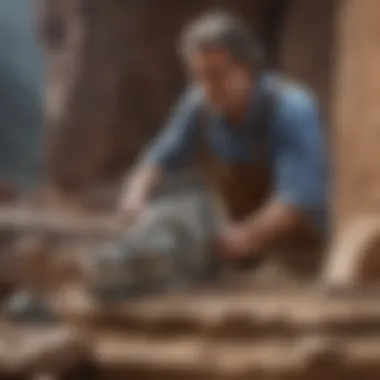
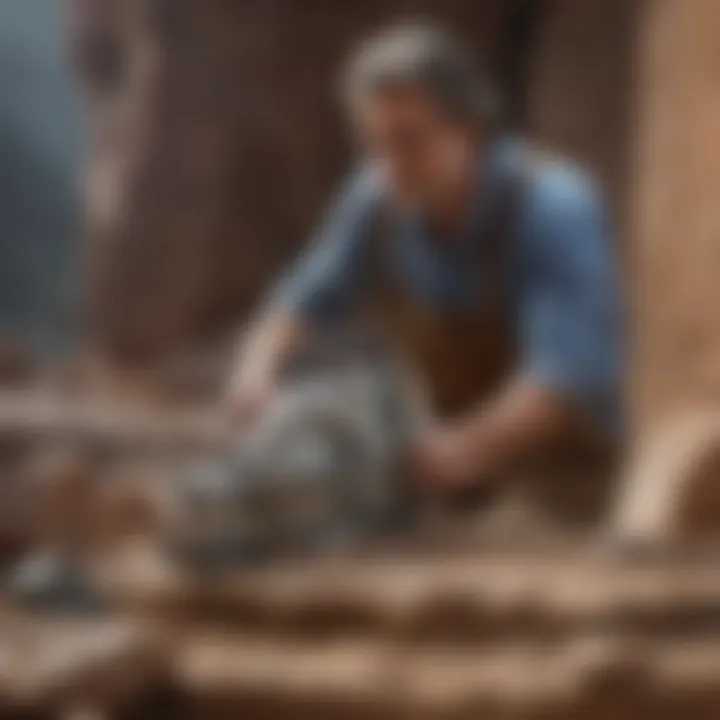
- Efficiency: Rock saws enhance cutting speed and precision, enabling miners to extract large blocks of stone with minimal wastage.
- Versatility: Modern rock saws can tackle various materials, from granite to limestone, making them essential across different formations.
- Cost-Effectiveness: By reducing the time and energy needed for cutting, rock saws significantly lower operational costs for quarries.
Companies engaged in stone cutting find that integrating rock saws into their production process scales results and improves profitability, ultimately leading to a more sustainable approach.
Artistic Sculpting of Rock
For artists and sculptors, rock saws are not just tools; they are gateways to creativity. The artistic use of rock saws transcends mere functionality, allowing for the transformation of raw stone into breathtaking sculptures:
- Creative Freedom: Artists are empowered to execute intricate designs with high precision, bringing their visionary concepts to life.
- Material Exploration: Rock saws allow for experimentation with various stones, such as marble and soapstone. Each type of stone presents unique challenges and opportunities for artistic expression.
- Alterations and Repairs: Should a mistake happen during the sculpting process, rock saws enable artists to make adjustments easily, ensuring the desired outcome.
For many, sculpting is a labor of love that requires both skill and the right tools. Rock saws bring dreams of art into physical existence, making them invaluable to any stone artist.
"The intricate relationships between these tools and their applications enrich our understanding of not just the rocks themselves, but the broader narratives they hold."
While the applications of rock saws are extensive, they also call for nuanced understanding and respect for the craft. Collectors, artists, and researchers alike benefit from mastering these indispensable tools.
Safety Considerations when Using Rock Saws
When engaging with rock saws, safety cannot be overstated. Missteps can lead to serious injuries, and the proper precautions are vital for preventing accidents. The use of rock saws demands a respect for the tools and the materials you are working with. Not only is it crucial for personal well-being, but it also protects those around you. Understanding safety measures can significantly enhance the effectiveness of your work while minimizing risks.
Personal Protective Equipment
Using rock saws does not come without its hazards, so equipping oneself with the right personal protective equipment (PPE) is essential. First and foremost, eye protection is critical. Specialized safety goggles offer a barrier against flying debris that can cause eye injuries. Without them, a simple slip can lead to a hefty visit to the hospital.
Beyond eye protection, durable work gloves should be worn. They help prevent cuts and abrasions from sharp rock edges and tools. Steel-toed boots are also non-negotiable; they can be the line between a minor bruise and a crushed foot.
Additionally, consider hearing protection, especially when using electric saws. The sound can be deafening over time, leading to permanent hearing loss.
In essence, wearing the right gear not just enhances safety; it gives you the freedom to focus on the task at hand without the looming thoughts of potential injuries.
Handling and Storage
Proper handling and storage of rock saws are as important as using them safely during operation. Each saw, regardless of its type, comes with specific handling instructions which should never be neglected. For example, when transporting a rock saw, always keep it turned off and securely stored. A sudden jolt or bump can cause an unintentional activation or damage.
Storing rock saws in a designated area, preferably in a dry and secure location, prevents rust and wear. Keeping the blades covered and well-maintained avoids accidental cuts when reaching for the tool. It’s wise to establish a routine for checking the condition of your tools before and after use to identify any potential issues that might arise from wear and tear.
A well-organized workspace not only enhances safety but also boosts efficiency. If the area is cluttered, you might trip or misplace important tools, leading to accidents and loss of time. Thus, a clean and orderly environment is paramount.
Emergency Procedures
Despite all safety precautions, unforeseen situations can arise. Therefore, having a clear set of emergency procedures can be the difference between a minor incident and a serious injury. Every user of rock saws should be well-versed in basic first aid. Knowledge of handling wounds, burns, or cuts can significantly reduce the severity of an injury.
It’s also wise to keep a first aid kit nearby, stocked with essentials like antiseptic wipes, bandages, and pain relief medication. Knowing how to apply these items quickly can be invaluable when every second counts.
Furthermore, establish a clear communication plan. If you're working with others, assign roles in case of an emergency. Whether it's dialing emergency services or guiding an injured person, teamwork is crucial. Have a phone within reach, and familiarize yourself with the nearest hospital or medical facility.
Remember: A proactive approach to safety, including preparation for emergencies, adds another layer of security to your rock-sawing adventures.
When dealing with rock saws, never underestimate the importance of safety. Equip yourself properly, handle tools with care, and always have a plan in case the unexpected happens.
Maintenance and Care of Rock Saws
Proper maintenance and care of rock saws is essential for both their longevity and performance. Neglecting these aspects can lead to decreased efficiency, safety hazards, and costly repairs. So, keeping your tools in top-notch condition isn't just good practice—it's fundamental to successful rock cutting and fossil preparation. This section outlines the key components of maintaining your rock saws, emphasizing what every collector and practitioner should consider.
Regular Inspection and Cleaning
Regular inspections and cleaning are the cornerstones of maintaining rock saws. Just like an old car needs periodic check-ups, rock saws benefit from routine evaluations. Practically speaking, checking the saw for any visible wear and tear—like cracks in the body or chips on the blade—can save you from a major malfunction during a critical cutting operation.
Cleaning the rock saw after each use is equally important. Remove any debris, dust, or residual rock material; it can mess with the blade’s efficiency and lead to uneven cuts. A good practice is to use compressed air or a soft brush to reach areas that are hard to access.
Here are some steps to follow:
- Visual Inspection: Look for any signs of superficial damage or wear.
- Clean Components: Use appropriate cleaning agents that won't damage the saw materials.
- Check Mechanical Parts: Ensure that all moving parts function smoothly.
"A stitch in time saves nine"—this old saying holds true for rock saw maintenance as well.
Blade Replacement and Sharpening
Blade maintenance is a vital element in the care of rock saws. Over time, blades can dull from constant use, leading to subpar performance and increased cutting time. Recognizing when a blade needs sharpening or replacement can significantly affect your work.
For sharpening, a specialized blade sharpener can be beneficial. Make sure to follow the manufacturer's guidelines to avoid damaging the blade. If you notice that sharpening doesn’t produce noticeable improvements, it might be time to invest in a new blade. When replacing a blade, it’s crucial to choose one that’s compatible with your specific rock saw model and suited for the type of rock you usually work with.
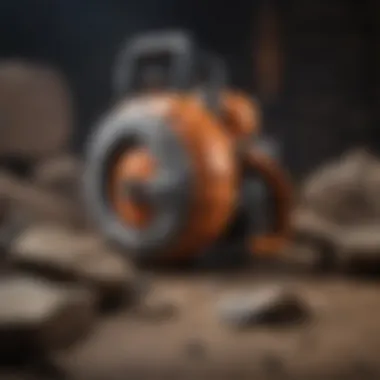

Consider these few pointers:
- Frequency of Sharpening: Depending on usage, blades may need sharpening after every few projects.
- Identify Wear: Look for signs like frayed edges or difficulty in cutting.
- Quality Replacement: Always opt for high-quality blades that meet your requirements.
Storage Practices
How you store your rock saw can make a world of difference in its lifespan. A clean, dry environment is essential for preventing rust and other types of corrosion.
Here’s where your storage decisions matter:
- Humidity Levels: Keep your working area well-ventilated. High humidity can shorten the life of the equipment.
- Blade Protection: Store blades separately when not in use and cover them to prevent accidental damage.
- Proactive Care: Consider using blade guards to protect the edges from physical wear during storage.
Investing the effort into proper maintenance and care will not only ensure that your rock saws run effectively but also provide peace of mind that you’re using reliable tools in your projects.
Technological Advancements in Rock Saws
In the world of rock cutting, technological innovations have brought significant changes that enhance efficiency, accuracy, and safety. This section delves into the cutting-edge developments in rock saw technology, focusing on how they contribute to the overall functionality and usability of these vital tools. From advanced materials to smart technologies, these advancements cater to both novices and professionals alike.
Innovative Designs and Materials
The design of rock saws has evolved markedly over the years. Modern saws often use lightweight, high-strength materials that reduce fatigue during prolonged use. For instance, aluminum alloys and carbon fiber are common in the construction of saw frames due to their excellent strength-to-weight ratio. These materials not only minimize the tool's weight, making it easier to handle, but also improve durability under harsh working conditions.
Moreover, blades have undergone a transformative redesign. For example, diamond-tipped blades have become the gold standard in rock saw applications, demanding higher precision and better cutting capabilities. With the advent of laser welding techniques, blade longevity has seen dramatic improvement. Unlike traditional methods, which could weaken blade integrity, these innovations ensure a more robust bond between the segments and the core, extending the lifespan of the blade substantially.
"The combination of innovative design and advanced materials has changed the game for rock saw users, allowing for greater versatility and efficiency in the field."
These newly designed rock saws also feature ergonomic handles and adjustable cutting angles, catering to specific cutting requirements and increasing user comfort. As professionals dive deeper into rock excavation and sculpting, such innovations become non-negotiable elements of their toolkit.
Smart Technologies Integration
As the world embraces the Internet of Things (IoT), rock saw technology isn't left behind. The integration of smart technologies is taking rock cutting to a new level. Intelligent sensors can now monitor the condition of blades and motor performance, providing immediate feedback to users. This real-time data allows for predictive maintenance, ensuring tools are serviced before they fail, which minimizes downtime and reduces repair costs.
Additionally, smart software applications can guide users in selecting the appropriate cutting techniques based on the material's specific characteristics. For example, some systems can recommend adjustments in speed and feed based on real-time rock types being cut, leading to a more tailored and efficient approach to each task.
With the rise of augmented reality, some companies are experimenting with these technologies to assist operators remotely, allowing experts to provide instant support by overlaying visual data onto the user's view. This not only enhances training for new operators but also boosts confidence during complex cuts.
Future Trends in Rock Saw Technology
The evolving landscape of rock saw technology stands at the forefront of innovation, reflecting changing needs within the geology and fossil preservation communities. As we delve into the future trends, it becomes vital to consider how these advancements will not only enhance operational efficiency but also align with sustainable practices and expand applicable use cases.
Sustainability in Manufacturing
Sustainability has emerged as a key driver behind the decisions made by manufacturers in the rock saw industry. The push towards minimizing environmental impact is not just a trend; it’s a necessity. Traditional manufacturing processes often contribute significantly to pollution. However, modern strategies prioritize eco-friendly materials and production techniques. For example, manufacturers are increasingly using recycled materials in the construction of saw blades and other components, which substantially reduces waste.
Moreover, energy efficiency is an area of focus. Newer models of rock saws are designed to operate with lower energy consumption. Integrating renewable energy sources, like solar power to run machinery, is on the rise. This offers not only environmental advantages but also cost savings for users in the long run. An added benefit is the durability of new designs. Modern rock saws are now built to last, which decreases the frequency of replacements, therefore lowering overall resource demand.
"By shifting to sustainable manufacturing practices, we are not just saving the planet, but also creating higher quality tools that serve us longer."
Emerging Applications in Research
The horizon of rock saw technology is broadening, with new applications arising in various fields of research. For instance, in palaeontology, the precise cutting capabilities of advanced rock saws allow researchers to extract and preserve delicate fossil remains with minimal risk of damage. Innovative saw designs can navigate complex geological formations, accessing hard-to-reach specimens while leaving surrounding material intact.
Moreover, the development of multifunctional rock saws is paving the way for interdisciplinary research. These tools can now easily transition from cutting through rock to performing detailed slicing for specimens in archaeological digs, thus widening their usage.
In addition, advancements in data integration, such as 3D modeling and imaging technologies, are being utilized in tandem with rock saws. This integration enables scientists to work with high levels of precision, allowing them to analyze geological structures or fossils before physically cutting or altering them.
This ability to visualize and simulate the results before engaging with the material also fosters safer and more effective research methodologies.
As we continue to see developments in this field, the rock saw will surely play an instrumental role in shaping future discoveries in both geology and paleontology. By embracing advancements in technology, those in the industry not only enhance their toolset but also pave the way for novel research avenues.
Epilogue
The conclusion serves as the concluding chapter of our exploration into rock saws, where we encapsulate the key insights and relevance of the subject matter. Rock saws are more than mere tools; they embody a rich history of development and innovation that continues to evolve. Understanding the intricate details about the types of saws, their operational techniques, and the safety measures is crucial, especially for enthusiasts engaged in rock and fossil preservation.
The article has delved deep into various aspects, from the types of rock saws such as manual and electric options to techniques for cutting and finishing. These segments lay the groundwork for collectors and professionals alike, emphasizing not only efficiency but also precision in their crafting efforts. Furthermore, the safety considerations are paramount. Using the right personal protective equipment, alongside proper handling and storage practices, contributes significantly to successful and safe operations.
As we look forward to the future of rock saw technology, trends in sustainability and innovative designs signal exciting prospects for both collectors and industries involved in geology. In summary, being well-versed with rock saws not only enhances practical skills but also fosters a deeper appreciation for geological preservation. If you grasp these points, you will be well-prepared to tackle projects that might range from hobbyist endeavors to academic pursuits.
Summary of Key Points
- Rock saws are essential tools for effective rock and fossil preservation, catering to both hobbyists and professionals.
- Knowledge about different types of rock saws enhances cutting efficiency and precision.
- Safety practices are non-negotiable; proper gear and techniques minimize risks associated with saw usage.
- Continuous advancements in rock saw technology pave the way for new applications in research and geology.
- Sustainable practices in manufacturing are gradually taking shape, reflecting a growing awareness of environmental concerns.
Encouraging Best Practices
To maximize the effectiveness of rock saw usage, it’s important to embrace a set of best practices. Here are crucial points to consider:
- Always wear protective gear: Safety goggles, gloves, and a dust mask should be standard attire during cutting tasks.
- Regular maintenance is key: Ensure all saw parts are kept in optimal condition through regular inspections and timely blade replacements.
- Follow operational guidelines: Every saw comes with its operating manual. Familiarize yourself with it thoroughly before use.
- Emphasize environmental awareness: When cutting stones or fossils, try to minimize waste. Efficient cuts lead to better material usage and preserve the integrity of the specimen.
- Engage with the community: Joining forums such as reddit.com or groups on facebook.com can provide you with valuable insights and shared experiences from fellow rock enthusiasts.
By adhering to these practices, collectors can not only protect their interests but also contribute positively to the field of geology.



